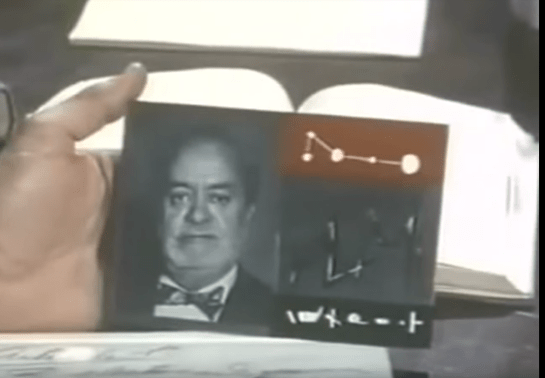Let’s cut to the chase. Las Luchadoras is a wholesale rip-off of Cybernauts, from the 1961–1969 British TV series The Avengers, specifically the episode “Return of the Cybernauts” from 1967. Thanks to readers Xavier Mouton-Dubosc @dascritch and Roger Long @evil_potato for drawing my attention to the complete ripoffery.

Compare freely…
- Bad robot is silver-faced, wears a black trench coat, does not speak, wears black sunglasses, and a black hat.
- Bad robot is given instructions via a graphically-designed card inserted into a machine slot.
- Bad robot smashes through walls to gain access to victims who stand there in horror rather than, say, running from the slow-walking golem.
- When bad robot kills, it does so with karate chops.
- Bad human captures scientists and forces them to provide engineering specs to fulfill his evil ambitions.
- Bad human forces scientists to build a wrist-wearable mind-control device, for use on Team Good. (One’s a bracelet. The other is a watch.) The main target for mind-control is a woman.
- Bad human has plans to use the mind-controlled person to fight the rest of Team Good.
- The day is saved (spoiler? I guess?) by pulling the mind-control device from the victim and putting it on the robot, which instead of granting the bad human more control of the robot, causes it to go berserk.
It’s like René Cardona saw “Return of the Cybernauts” on TV, loved it, and thought there is only one thing that could make this better: Lady. Wrestlers. So he added luchadoras and hoped BBC Four wouldn’t notice. He just wanted to make the world better, y’all.
If you think I’m exaggerating, here are a few side by side shots.
The main differences from the technology point of view is that in “The Cybernauts” (the first episode from The Avengers to feature the robots, when the series was still shot in black and white), the robots didn’t track their victims by heartbeat. The robots followed a radio signal emitted from a pen that was gifted to the victim. In “The Return of the Cybernauts,” they’d gotten an upgrade, and did their tracking via sensors that were all on board.
Additionally, in The Avengers, the victim card is inserted into an angled control panel attached to a wall-sized computer. In Luchadoras, the card is inserted into a slot built into the Robot Asesino. (The next post.) Otherwise, the steps of interaction are the same.
Which brings us to the Victim Cards
Behold them, side-by-side.
It’s easier to tally the differences than the similarities, because they are quite alike.
- Avengers’ cards are affixed to transparent plastic. Luchadoras’ cards are a thick paper.
- Avengers’ has its elements separated by light blue rule lines. Luchadoras’ has no borders.
- Avengers’ has a numeric unique identifier in the lower left.
- Avengers’ top graphic looks like black computer-readable shapes on a white background. (Though it was almost certainly graphic tape.) Luchadoras’ looks like a white star chart on a red background.
- Avengers’ middle graphic is clearly a cardiogram (even if cardiograms are continuous not plotted points). Luchadoras’ is hard to read because of the crappy transfer, but nothing like a cardiogram.
- Avengers’ lower graphic looks something like white braille pips on a red background. Luchadoras’ is weird white glyphs on a black background.
So…Who did it better?
Let’s not use the low resolution of this transfer against Luchadores. And we won’t use the lack of trippy face-stabilizing algorithms in the transfer of The Avengers against it.
Production
The bits on The Avengers’ card are clearly pasted there. The corners are curling up! But the plastic card feels solid and monumental. Luchadoras’ card seems like it was printed the way we see it! Using a color printer today, this would be a no big deal. But back in 1969 this was quite an achievement. Luchadoras wins.
Graphics
Avengers top graphic is perfect. Like an early version of OCR. It’s very convincingly an instruction for a computer: precise and high contrast. Sadly the cardiogram is a little off, since even if it was plotted points, those points would be evenly spaced, and having the irregular plots on graph paper only highlights the unevenness. The braille-like bits at the bottom are, again, very convincingly an instruction for a 1960s computer to easily read.
Luchadores’ is just…nonsensical. A star chart? Hieroglyphs? “Cardiogram” lines that go backwards and cross back over themselves?
Avengers wins, leaving us with a need for a tie-breaker.
Diegetic usability
This is the main measure, and I’m just being coy for leaving it to the last. The purpose of the card is for henchmen and bad guys to provide programs for a robot assassin.Luchadoras’ space-filling layout and production quality make it look more in-line with modern design sensibilities on the surface, the actual content of those graphics are just 4th-wall-destroyingly awful.
Plus, since, the Avengers’ has the unique ID that makes it easy to for the humans to talk about with each other,…
“Get me the Peel card!”
“Uh, which is that?”
“The only person presenting as a woman?”
“Wut?”
“1252.”
“Oh, Hahaha. Got it.
…it wins.
If you’re going to copy, Luchadoras, seek to deeply understand the thing you’re copying first.
For more Who Did it Better, see the tag. Right now there’s only the fingernail-o-matics from The Fifth Element and Total Recall, but I’ll tag future things with that same tag.





